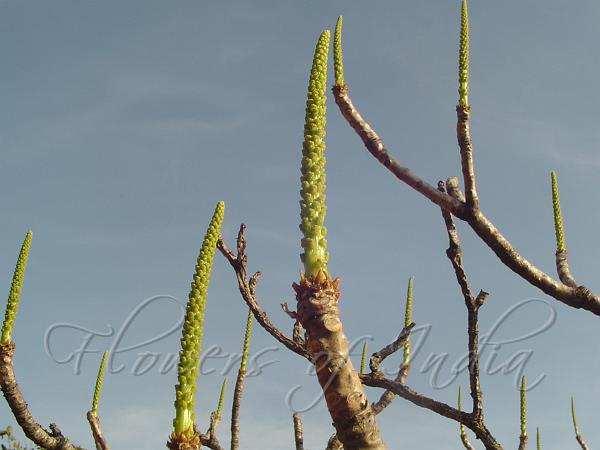|
| Tiger's Milk Spruce |
|

|

| File size | 1015417 |
| Original date | 12/23/07 9:09 AM |
| Resolution | 2048 x 1360 |
| Flash | Flash did not fire |
| Focal length | 6.3mm |
| Exposure time | 1/400s |
| Aperture | 8.0 |
| Focus Distance | |
| Metering Mode | Spot |
| Camera make | SONY |
| Camera model | DSC-P52 |
| Sensor type |
|
|
|
|
Photo: |
Botanical name: Falconeria insignis Family: Euphorbiaceae (Castor family)
Synonyms: Sapium insigne, Falconeria malabarica, Excoecaria insignis
Synonyms: Sapium insigne, Falconeria malabarica, Excoecaria insignis
Tiger's Milk Spruce is a small tree, 5-10 m high, with horizontal branches,
exuding poisonous milky juice. Oppositely arranged elliptic-lanceolate
leaves with serrated margins, 16-19 x 5-8 cm, are crowded at the ends of
branchlets. Leaves have pointed tips, base acute or wedge-shaped, unequal;
leaf-stalk 4-5 cm long. Flowers small, unisexual, in terminal 7-9 cm long,
upright, stout, spikes, with a whorl of linear scales at base. Male flowers
less than 1 mm long, in sessile cluster, in the axils of adpressed bracts.
During flowering, the tree has a curious appearance - it is completely
leafless, with only long, sharp, upright spikes at the end of branches.
Members of this genus are invariably hazardous. In Mexico, the milky sap is
reputed to be harmful and the American Indians utilised it for poisoning
their arrows. In Salvador, the sap is claimed to be poisonous and
blistering in effect if in contact with the skin for which reason the trees
are often left standing when the land is cleared.
Flowering: December-January.
| Identification credit: Dinesh Valke | Photographed in Maharashtra & Uttarakhand. |
• Is this flower misidentified? If yes,